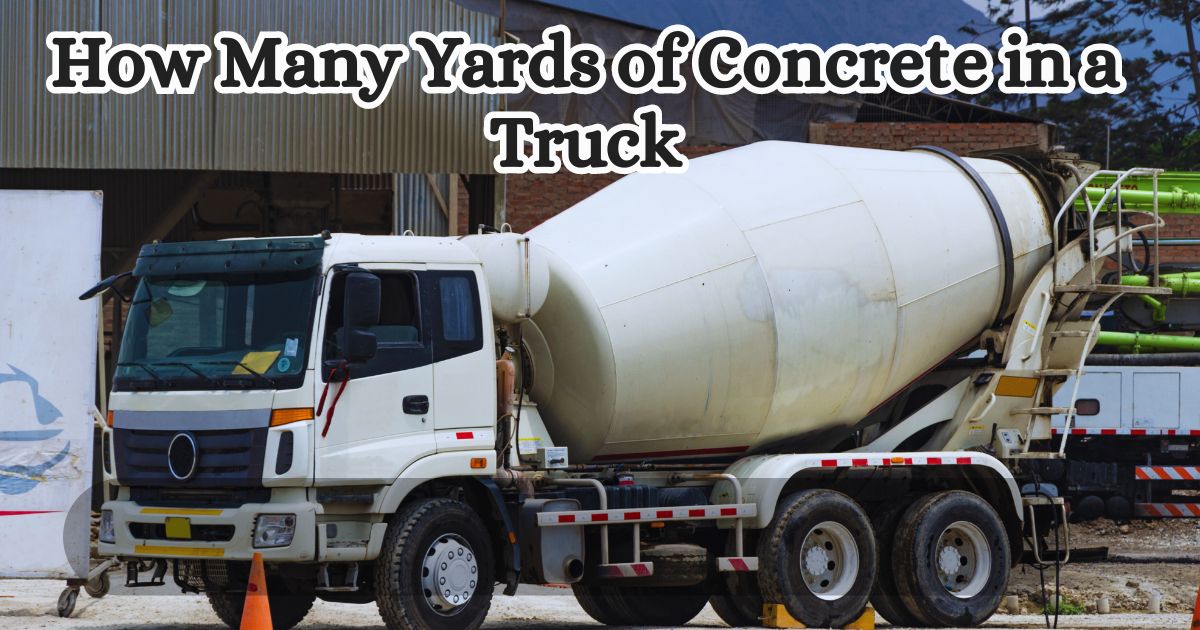Understanding how many yards of concrete in a truck is crucial for any construction project. Whether you’re working on a residential driveway or a large commercial building, knowing the capacity of your concrete truck helps ensure you order the right amount. This guide covers key aspects of concrete truck capacities, calculations, and best practices for effective use.
Understanding Concrete Truck Capacities
Types of Concrete Trucks
Concrete trucks come in various types, each designed for specific needs. The most common types include:
- Standard Mixer Trucks: These trucks, often used for residential projects, typically carry 8 to 10 cubic yards of concrete.
- Rear Discharge Trucks: Ideal for tighter spaces, these trucks discharge concrete from the rear, providing better control over the placement.
- Front Discharge Trucks: These trucks offer greater maneuverability and are useful for complex pours or challenging site conditions.
Average Capacities
Concrete truck capacities vary based on their design and purpose. Here’s a breakdown of typical capacities:
- Standard Trucks: Usually hold between 8 and 10 cubic yards of concrete.
- Large Trucks: Some can carry up to 12 or more cubic yards, suited for large-scale projects.
Understanding these capacities helps in planning your concrete orders effectively.
Calculating Concrete Needs
Basic Calculation Methods
To determine how many yards of concrete you need, follow these steps:
- Measure the Area: For a slab, measure the length, width, and thickness.
- Calculate the Volume: Multiply these measurements to get cubic feet.
- Convert to Cubic Yards: Divide the cubic feet by 27 to convert to cubic yards.
- Add Extra: Include an additional 10% to account for spillage and over-excavation.
Using these calculations ensures you order the correct amount of concrete for your project.
Advanced Calculation Techniques
For complex projects, more detailed calculations may be necessary. Consider these techniques:
- Use Concrete Calculators: Online tools can simplify calculations by allowing you to input measurements and automatically compute the volume.
- Consult a Professional: For intricate or large-scale projects, a concrete supplier can provide expert guidance on precise calculations.
Real-World Examples
Residential Concrete Projects
In residential construction, the amount of concrete needed depends on the project size. For example, a standard driveway might require 6 to 10 cubic yards. Accurate measurements and calculations help ensure that the concrete is delivered correctly and efficiently.
For smaller projects, such as patios, a partial load or smaller truck may suffice. Proper planning avoids waste and reduces costs.
Large-Scale Commercial Projects
Commercial projects, like parking lots or building foundations, require more concrete. These projects often use trucks with capacities of 10 to 14 cubic yards or more.
Effective planning and coordination are essential to handle the large volumes and multiple truckloads involved. Working closely with suppliers ensures timely and accurate deliveries, maintaining project flow.
Loading and Delivery Considerations
Maximizing Truck Capacity
Maximize your truck’s capacity by:
- Following Loading Guidelines: Ensure the truck is filled without exceeding weight limits.
- Maintaining Balance: Load the truck evenly to avoid imbalances that can affect handling.
Proper loading techniques minimize spillage and ensure that the concrete arrives in optimal condition.
Delivery Time and Scheduling
Timing is crucial for concrete delivery. Ensure that concrete is delivered at the right time for proper pouring and setting. Coordinate with your construction team to plan deliveries around factors like weather and site access.
Accurate scheduling helps avoid delays and ensures that concrete is placed correctly, contributing to a smooth construction process.
Choosing the Right Truck for Your Project
Factors to Consider
When selecting a concrete truck, consider:
- Project Size and Design: Choose a truck that matches the volume needed.
- Site Accessibility: Determine if a rear or front discharge truck is necessary based on site conditions.
Understanding these factors ensures you select the appropriate truck for your needs.
Consulting with a Concrete Supplier
Work closely with a concrete supplier to determine the right truck and ensure your concrete needs are met. Suppliers provide valuable insights into truck capacities, mix options, and delivery scheduling.
Collaboration with suppliers helps guarantee that your concrete is delivered on time and in the correct amount, supporting successful project completion.
Also Read: Loyce Means Released
Troubleshooting Common Issues
Overloading Concerns
Overloading a concrete truck can cause safety hazards and equipment damage. To prevent overloading:
- Adhere to Load Limits: Follow the truck’s capacity guidelines.
- Measure Accurately: Ensure that the truck is filled within its specified limits.
Address any overloading issues promptly to maintain safety and avoid potential problems.
Underestimating Concrete Needs
Underestimating concrete needs can lead to delays and extra costs. To avoid this:
- Conduct Accurate Calculations: Measure and calculate carefully before ordering.
- Consult a Supplier: Get expert advice to ensure you order enough concrete.
If a shortage occurs, arrange additional deliveries or adjust the project schedule to minimize disruptions.
Case Studies
Residential Construction Example
In a typical residential project, such as pouring a driveway, accurate volume calculation is critical. For example, a driveway needing 8 cubic yards of concrete was successfully completed by selecting a truck with matching capacity. This approach ensured efficient delivery and minimal waste.
Large-Scale Commercial Project
For a commercial foundation requiring 100 cubic yards of concrete, multiple trucks with higher capacities were used. Careful planning and coordination with suppliers ensured timely and accurate delivery, contributing to the project’s success.
Innovations in Concrete Truck Design
Technological Advancements
Recent innovations include:
- GPS Tracking: Enhances delivery efficiency by monitoring truck location.
- Automated Mixing Systems: Ensure consistent concrete quality and reduce manual labor.
- Enhanced Discharge Mechanisms: Allow precise placement and reduce waste.
These advancements improve concrete truck performance and delivery efficiency.
Future Trends in Concrete Transport
Future trends include:
- Eco-Friendly Trucks: Electric or alternative fuel trucks aim to reduce environmental impact.
- Smart Technology: Integrates data analytics to optimize transport and delivery.
These innovations will shape the future of concrete transport, enhancing efficiency and sustainability.
Conclusion
Knowing how many yards of concrete in a truck is essential for planning construction projects. Concrete trucks come in various sizes, each suited for different needs. Accurate calculations, careful truck selection, and effective scheduling ensure that you order and use the right amount of concrete.
Understanding how many yards of concrete in a truck helps you determine the appropriate truck size for your project. Choosing the right concrete truck involves evaluating your project’s needs, understanding truck capacities, and coordinating with suppliers. Following best practices and staying informed about industry trends will help you manage concrete deliveries efficiently and achieve successful project outcomes.










